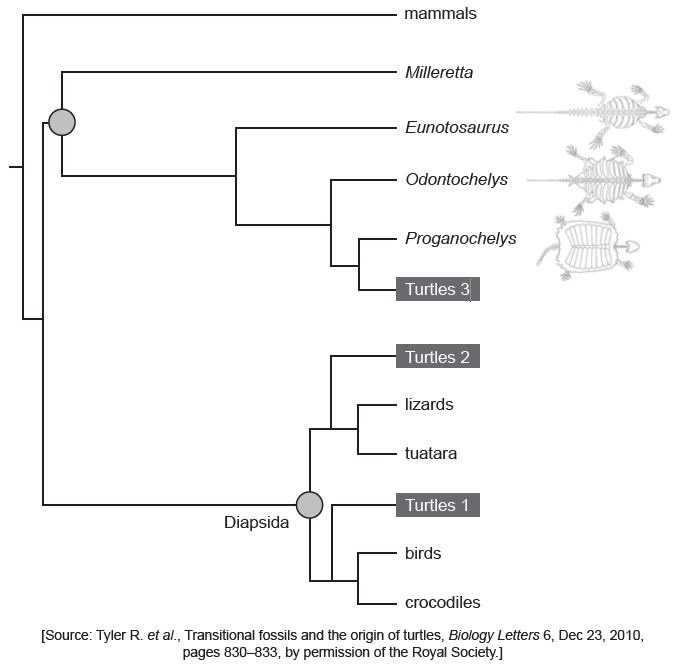Question
Eukaryotes are classified into kingdoms, one of which is the animal kingdom.
(a) Describe the organelles and other structures in animal cells that are visible in
electron micrographs.
(b) Explain how animal cells produce the ATP that they need.
(c) Distinguish between reptiles and amphibians in terms of their recognition features.
Answer/Explanation
Answer:
(a)
a. plasma membrane is thin layer forming outer boundary;
b. cytoplasm fills space between membrane and nucleus;
c. nucleus enclosed in nuclear membrane / nuclear membrane enclosing
nucleus;
d. chromosomes inside the nucleus/ visible during mitosis/ as rods (of condensed
DNA);
e. mitochondria with cristae/double membranes;
f. (80S) ribosomes seen as dots free in cytoplasm/attached to rough ER;
g. endoplasmic reticulum is a network interconnected tubes/ membranes /rough
ER has ribosomes/ smooth ER does not;
h. Golgi apparatus with stack of sacs/cisternae/curved or folded membranes/
vesicles budding off;
i. vesicles which are small membrane sacs;
j. lysosome which contains enzymes/which is densely staining;
k. any other organelle that would be visible correctly described;
(b)
a. respiration/cell respiration;
b. energy released from glucose/lipids/organic compounds;
c. anaerobic respiration does not require oxygen;
d. lactate is produced in anaerobic respiration/word equation for anaerobic
respiration;
e. oxygen used in aerobic respiration;
f. carbon dioxide and water produced in aerobic respiration/word equation for
aerobic respiration;
g. mitochondria used for aerobic respiration;
h. larger yield of ATP from aerobic than anaerobic respiration;
(c)
a. reptiles dry skin versus amphibians moist skin;
b. reptiles with scales versus amphibians not having scales / reptiles scaly skin
versus amphibians soft skin;
c. reptile eggs have (soft) shells versus amphibian eggs no shell/coated in gel;
d. reptiles internal fertilisation/sperm enters female versus amphibians external
fertilisation
OR
amphibians require water for reproduction, reptiles do not;
e. reptiles do not have larval stage versus amphibians have larval stage;
f. reptiles do not develop gills versus amphibian larvae have gills;
Question
The diagram shows a leaf from Dryopteris arguta.

State the phylum of this plant.
State two characteristics of plants from the phylum you stated in (a)(i).
Outline why the number of trophic levels is limited in a food chain.
▶️Answer/Explanation
Markscheme
Filicinophyta/Filicinophytes/Pteridophytes
Reject “ferns”
a. have roots, stem and leaves
All three, roots, stem and leaves required
b. pinnate leaves/leaves divided «repeatedly» into leaflets
c. have vascular tissue/xylem and phloem
d. produce spores/sporangia
OR
no flowers/fruits/seeds
[Max 2 Marks]
energy losses between trophic levels
OR
only part of the energy in one trophic level will become part of the next trophic level
Question
Mutations are the ultimate source of genetic variation and are essential to evolution.
Lice are wingless insects that belong to the phylum arthropoda.
State one type of environmental factor that may increase the mutation rate of a gene.
Identify one type of gene mutation.
State two characteristics that identify lice as members of the arthropoda.
1.
2.
Some lice live in human hair and feed on blood. Shampoos that kill lice have been available for many years but some lice are now resistant to those shampoos. Two possible hypotheses are:

Discuss which hypothesis is a better explanation of the theory of evolution by natural selection.
▶️Answer/Explanation
Markscheme
a. radiation
b. chemical mutagens/carcinogens/papilloma virus/cigarette smoke
base substitution/insertion/deletion/frameshift
a. jointed appendages
b. «chitinous» exoskeleton
c. segmented body
OR
bilateral symmetry
OR
mouth AND anus
OR
paired appendages
a. «scientists would accept» hypothesis A as the better one as mutations are random
b. scientists would reject hypothesis B because characteristics acquired during the lifetime of the individual being inherited is Lamarckian/not part of the evolution by natural selection theory/not all mutations are heritable
c. «the resistance» mutation would be present in the population initially and not caused by the shampoo «as hypothesis B states»
d. both hypotheses include variation in the population of lice «resistant and non-resistant»
e. variation is necessary for natural selection to occur
f. frequency of the best adapted increases and these individuals reproduce/pass on resistance to their offspring, so the resistant population increases «so hypothesis A is better»
OWTTE can be used for any of the answers in this part.
Question
The following cladogram shows three possible evolutionary routes for the turtle (Turtles 1, Turtles 2 and Turtles 3). The taxa in italics are extinct.

State the organism most closely related to the lizards.
Based on the taxa shown, deduce a difficulty in gathering data to study turtle ancestry.
Molecular evidence is often used to construct a cladogram. Describe one type of molecular-based evidence to identify members of a clade.
Suggest one type of additional evidence that could provide strong support for Turtles 3 as the evolutionary route for turtles rather than Turtles 1 or Turtles 2.
Taxonomists aim to place species into genera, families and higher taxa according to their evolutionary origins. This is known as natural classification.
Explain the usefulness of natural classification in biodiversity research.
▶️Answer/Explanation
Markscheme
Tuatara
some «taxa» are extinct
OR
convergence «of body form» could have occurred (confusing interpretation of the data)
a. base sequences of a gene/DNA/mtDNA
OR
amino acid sequences of a protein
b. species with the most similarities «in base sequence/amino acid sequence/genomes» have recently diverged/a common ancestor/are closely related
OR
members of a clade accumulate the fewest mutations on same base sequences/ vice versa / OWTTE
fossils / comparative anatomy / homologous structures / vestigial structures
a. «because» it allows easier identification of a species
b. «because» it can help identify common ancestors/evolutionary paths/close relationships (showing degree of biodiversity) / OWTTE
c. «because» it is universal/cross-cultural language that avoids problems of local names of organisms
OR
«because» it promotes international collaboration
OR
«because» it facilitates access to the history/background of the species /indexing for retrieval of relevant «taxonomic» information / OWTTE
d. «because» it allows «biodiversity» research of larger taxa «ie examination of a family of large cats rather than one species»
Question
The continued survival of all living organisms depends on sustainable communities in which plants play a vital role.
(a) Outline how energy flows in an ecosystem.[4]
(b) Describe how plants affect the amount of carbon dioxide in the atmosphere.[4]
(c) Explain how a newly discovered plant species would be classified and named.[7]
▶️Answer/Explanation
a. energy from the sun is captured by plants/autotrophs:
b. light energy is converted to chemical energy by photosynthesis;
c. energy is passed to animals/consumers/along the food chain;
d. at each stage in the food chain energy is lost by respiration/as heat;
e. much less energy/only about $10 \%$ is available at each stage/trophic level of the food chain;
f. some energy is made available to decomposers when organisms die/parts fall to the ground;
g. energy cannot be recycled
b
a. plants reduce the amount of carbon dioxide in the atmosphere by photosynthesis:
b. carbon dioxide is fixed/converted into organic substances/sugars/ OWTTE;
c. plants respire which releases carbon dioxide into the atmosphere;
d. plant decomposition may release $\mathrm{CO}_2$
e. carbon in dead plants is trapped/ stored in fossil fuels / peat
f. combustion of plants/wood/ fossil fuels adds to the amount of carbon dioxide in the atmosphere;
c
Naming:
a. binomial nomenclature / (plant is) given a binomial/double name;
b. first name is the genus and second name is the species / genus initial upper case and species lower case;
c. names (of plant species) are international/are universally understood/are published in journals;
Classification:
d. study the characteristics/structure/reproduction/chemical properties/DNA (of the plant);
e. put/classify (the plant) in a group/genus with other similar species;
f. natural classification corresponds with evolution / natural classification is based on many features
g. analogous features/features due to convergent evolution should not be used;
h. hierarchy of groups/taxa (in traditional classification / 3 or more taxa in correct sequence (kingdom-phylum-class);
i. two or more of bryophyta, filicinophyta, coniferophyta and angiospermophyta named;
j. a clade is a group of organisms evolved from a common ancestor;
k. base sequences/amino acid sequences used to group organisms into clades/deduce evolutionary relationships;
I. cladograms show the relationships between clades/likely evolutionary divergence of clades;
$\mathrm{m}$. each branch point/node represents where species are formed via divergent evolution;
n. species are now classified into a sequence of clades (rather than a rigid hierarchy of taxa);